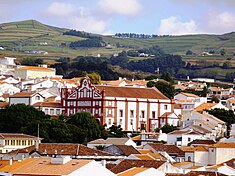Convent of São Francisco (Angra do Heroísmo)
| Convent of São Francisco (Convento do São Francisco) | |
| Convent of Saint Francis of Assissi, Church of Our Lady of the Guide, Museum of Angra do Heroísmo | |
| Convent (Convento) | |
|
The large Church of Nossa Senhora da Guia, part of the Convent grounds of São Francisco in the city of Angra do Heroísmo
|
|
| Official name: Convento de São Francisco/Igreja de Nossa Senhora da Guia/Museu de Angra do Heroísmo | |
| Named for: Francis of Assissi | |
| Country | |
|---|---|
| Autonomous Region | |
| Group | Central |
| Island | Terceira |
| Municipality | Angra do Heroísmo |
| Location | Sé |
| Style | Baroque |
| Origin | c. 1470 |
| - Initiated | c. 1663 |
| - Completion | 1 October 1672 |
| Owner | Portuguese Republic |
| For public | Private |
| Visitation | Closed |
| Management | Direção Regional de Cultura |
| Operator | Câmara Municipal de Angra do Heroísmo |
| Status | Property of Public Interest |
| Listing | IIP, Decree 47/508; DG, Série I (20) 24 January 1967; included as part of the Historica Centre of Angra do Heroismo (PT071901160035) |
|
Location of the convent in the municipality of Angra do Heroismo
|
|
The Convent of São Francisco is a Baroque-era convent and church in the historical centre of the city of Angra, civil parish of Sé, municipality of Angra do Heroísmo on the Portuguese island of Terceira, in the archipelago of the Azores. Better recognizable for the large Church of Our Lady of the Guide (Portuguese: Igreja de Nossa Senhora da Guia), is its locally known as the Igreja do Convento de São Francisco, (Church of the Convent of São Francisco), one of the largest of Christian temples in the Azores, and former seat of the Franciscan Province of São João Evangelista, during the Age of Discovery.
The first Franciscan monks arrived on Terceira around 1456: almost immediately, they began to construct a hermitage and, much later, around 1470, a convent.
This primitive group was eventually demolished, and a larger, more imposing temple was constructed. In 1663, frair Naranjo had accumulated the donations necessary to begin construction of the new group. Three years later, the dormitories and cells were already concluded, while on 6 March 1666, the first cornerstone was placed for the new Church.
On 1 October 1672, the project was completed, and the group was blessed by the Bishop of Angra, Lourenço de Castro, after a solmen procession that included members of the civil authority, military and ecclesiastical orders.
It was at the convent that António, Prior of Crato lived during his exile in the Azores, until 1583.
After the Liberal Revolution of 1820, with the diffusion of liberal idealism throughout the country and archipelago, in 1823, four clergy, five monks and 11 laymen who professed these ideas were detained in the convent. The group were captured in Praia and transferred under military escort to Angra. They entered by the Porta dos Carros (Carriage Gate), were they encountered local absolute monarchists, armed with iron cuttings who attempted to lynch the free-thinks.
...
Wikipedia


